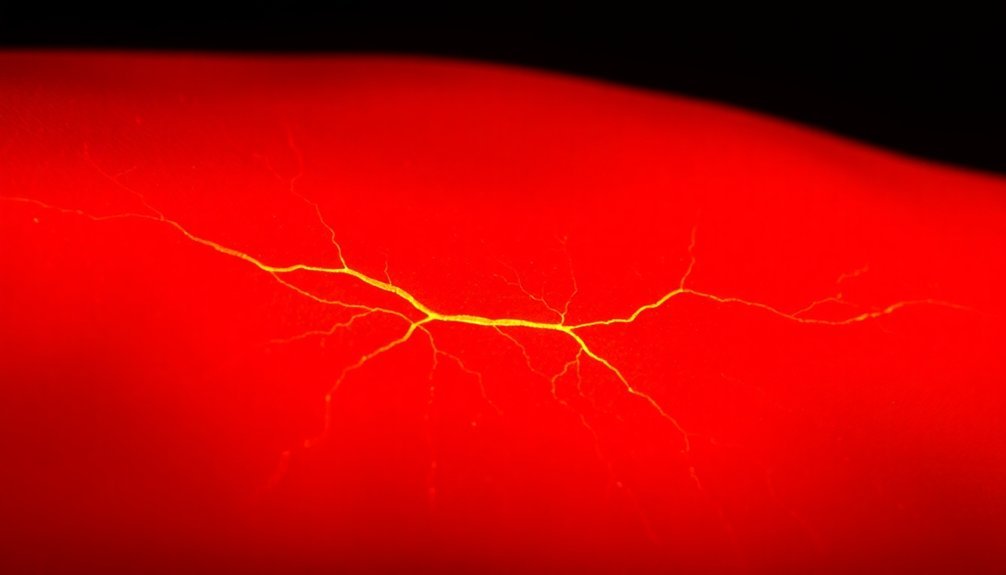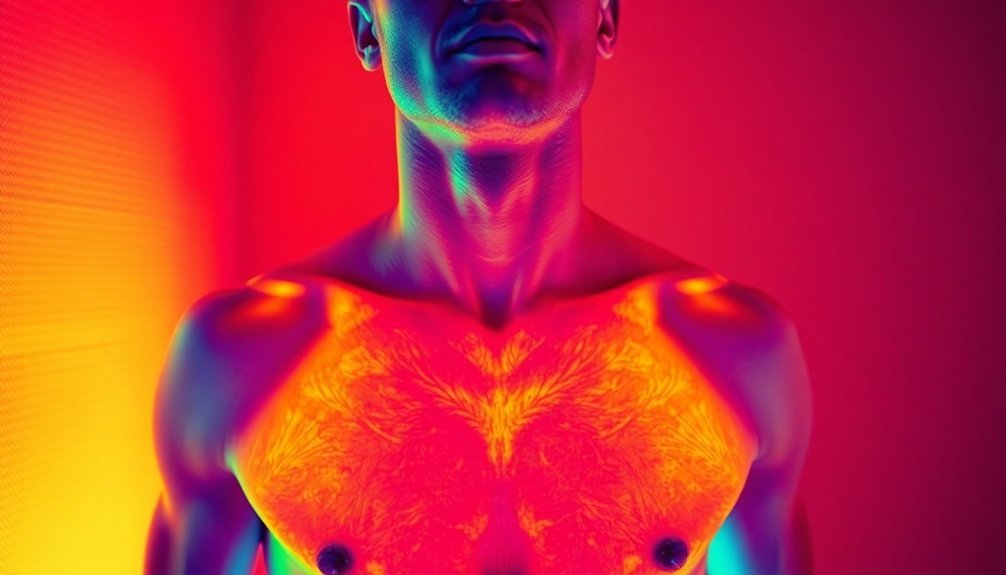NIR light therapy can help activate your body's natural testosterone production by using specific wavelengths between 700-1000nm. This light penetrates deep into your tissues, stimulating the Leydig cells in your testicles that produce testosterone. The therapy works by enhancing mitochondrial function and ATP production, energizing your cells to boost hormone synthesis. Clinical studies show promising results, with one Italian study demonstrating testosterone increases from 2.1 ng/ml to 3.6 ng/ml in just two weeks. When combined with red light (600-700nm), you'll get both surface and deep tissue benefits. Understanding the precise wavelengths and protocols will maximize your hormonal optimization journey.
How NIR Light Boosts Testosterone

Three key mechanisms explain how NIR light therapy boosts testosterone production in men. First, NIR light directly stimulates your Leydig cells, which are responsible for producing testosterone in the testes. When these cells receive NIR wavelengths between 700-900 nm, they become more active and efficient at hormone production. Effective treatment sessions typically last 10-20 minutes, performed three to four times weekly for optimal results.
Second, NIR light enhances mitochondrial function by stimulating cytochrome C oxidase, an essential enzyme in your cellular energy production. This process energizes and polarizes the mitochondria in your Leydig cells, leading to increased ATP synthesis. With more energy available, your cells can produce testosterone more effectively.
The third mechanism involves your pineal gland, which plays a vital role in reproductive health. NIR light therapy interacts with this gland, optimizing its function and supporting overall hormonal balance. Research, including the 2016 University of Siena study, has demonstrated that men with low sexual desire experienced increased testosterone levels after light therapy treatment.
You'll find these effects are achievable through at-home devices that combine 630-700 nm red LED light with 700-900 nm NIR light, offering a safe, natural way to boost your testosterone levels without side effects.
Scientific Evidence Behind Light Therapy
Clinical studies have shown promising results for light therapy's impact on testosterone production. A groundbreaking 2016 Italian study from the University of Siena demonstrated that men receiving morning light therapy experienced a significant boost in testosterone levels, jumping from 2.1 ng/ml to 3.6 ng/ml in just two weeks. The research involved 38 men with diagnosed low sexual desire, providing compelling evidence for light therapy's effectiveness.
Scientists have identified several key mechanisms behind these impressive results:
- Light therapy influences your hypothalamic-pituitary axis, which controls testosterone production by signaling your testes.
- Red light exposure increases cellular energy and ATP production in your Leydig cells, enhancing their ability to synthesize testosterone.
- Photoreceptive proteins in your testicles respond to specific light wavelengths, potentially boosting hormone production.
- Light therapy energizes mitochondria in Leydig cells, which is essential for healthy testosterone synthesis. Unlike traditional heat-based therapies, red LED and NIR light generate minimal heat, making them completely safe for testicular treatment.
The evidence suggests that combining short red LED waves (630-700 nm) with longer NIR waves (700-900 nm) provides the best results. While more research is needed, current studies indicate that light therapy offers a safe, natural approach to supporting testosterone production without the risks associated with traditional hormone replacement therapies.
Optimal Wavelengths For Male Enhancement

Several specific wavelengths of light therapy have proven particularly effective for male enhancement, with the most promising results coming from a combination of red light (600-700nm) and near-infrared (NIR) light (700-1000nm). These wavelengths work together to stimulate blood flow, enhance cellular function, and boost nitric oxide production. Studies show that these wavelengths help enhance testosterone production through improved cellular energy in Leydig cells.
| Wavelength Range | Primary Benefits |
|---|---|
| 600-700nm (Red) | Increases microcirculation, enhances testicular health |
| 700-1000nm (NIR) | Deep tissue penetration, improves erectile function |
| 650-850nm (Combined) | Maximizes therapeutic outcomes, ideal coverage |
You'll get the best results using devices that deliver both red and NIR light simultaneously. The red light specifically targets surface-level tissue and blood vessels, while NIR penetrates deeper – up to three inches into the body. This deeper penetration is vital for reaching the internal structures of the penis and promoting healthy blood flow. For effective treatment, look for devices that can deliver both continuous and pulsed waves, with a ratio of 70% continuous to 30% pulsed. This combination enhances the therapeutic effects and promotes better absorption of the light energy.
Treatment Protocol And Best Practices
While establishing an effective treatment protocol requires careful consideration of multiple factors, starting with the right approach can optimize your results from red light therapy.
You'll want to begin with shorter 10-15 minute sessions at lower intensities, gradually increasing duration and power as your body adapts. When targeting testosterone production, focus treatment on your head, neck, and testicular areas using panels, masks, or handheld devices. Testosterone levels below 300 ng/dL generally indicate a need for therapeutic intervention.
- Start with wavelengths between 630-700 nm for red light and 700-900 nm for NIR light
- Maintain consistent treatment sessions while monitoring your body's response
- Keep devices at a safe distance from your eyes and watch for any skin sensitivity
- Combine therapy with lifestyle improvements like stress management and exercise
If you're considering combining red light therapy with testosterone treatments, consult your healthcare provider first. They'll help determine the most effective protocol for your specific needs.
Remember that while this therapy is natural and non-invasive, pregnant or nursing individuals should seek medical clearance before starting. Clinical studies support its effectiveness, showing significant testosterone increases within two weeks of proper treatment.
Safety And Long Term Benefits

After understanding the proper treatment protocol, it's important to recognize the remarkable safety profile and sustained advantages of red light therapy. Unlike blue light, red LED and NIR light won't burn your skin, damage your DNA, or disrupt your natural hormone production. You'll benefit from regulated wavelengths between 600-950nm that have been proven safe and effective.
The long-term benefits you'll experience go beyond just testosterone enhancement. Your body will respond with improved cellular energy, enhanced sexual function, and reduced inflammation, all while maintaining healthy sperm production.
| Benefit Category | What You'll Get | Why It Matters |
|---|---|---|
| Safety | No heat damage | Protects tissue integrity |
| Hormonal | Increased testosterone | Better sexual health |
| Cellular | Enhanced ATP production | More energy & vigor |
| Reproductive | Improved sperm health | Better fertility |
| Overall Health | Reduced inflammation | Less chronic pain |
You're choosing a natural, non-invasive method that supports your body's own testosterone production mechanisms. The therapy works by stimulating your mitochondria and photoreceptors, leading to improved hormone regulation without the risks associated with pharmaceutical alternatives.
Frequently Asked Questions
Can Red Light Therapy Help Reverse Testosterone Decline From Steroid Use?
Yes, red light therapy can help reverse testosterone decline from steroid use by stimulating your Leydig cells and boosting natural production. It's most effective when you combine it with proper post-cycle therapy protocols.
Does Wearing Clothing During Treatment Reduce the Effectiveness of Red Light Therapy?
Yes, wearing clothes reduces red light therapy's effectiveness. You'll get the best results with direct skin exposure, but if needed, use thin, light-colored, natural fabrics like cotton to minimize the impact.
How Does Red Light Therapy Interact With Testosterone Replacement Medications?
You can safely combine red light therapy with testosterone replacement medications. It may enhance your treatment's effectiveness by stimulating natural testosterone production while supporting your body's response to the prescribed medications.
Can Women Safely Use Red Light Therapy for Hormone Optimization?
You can safely use red light therapy for hormone optimization, but you'll want to consult your healthcare provider first. It's effective for regulating estrogen and progesterone levels, easing menstrual and menopause symptoms.
Does Time of Day Affect the Effectiveness of Red Light Therapy Treatments?
Yes, timing can impact your results. You'll typically get the best benefits from morning sessions for energy and performance, while evening sessions work well for relaxation and sleep. Consistency matters more than exact timing.
In Summary
You've discovered how near-infrared light can naturally boost your testosterone levels through targeted light therapy. By following the recommended protocols and using the ideal 850nm wavelength, you'll support your body's hormone production safely and effectively. Remember to maintain consistency with your treatments, protect your eyes, and give your body time to respond. Start with short sessions and gradually increase exposure for the best long-term results.





Leave a Reply